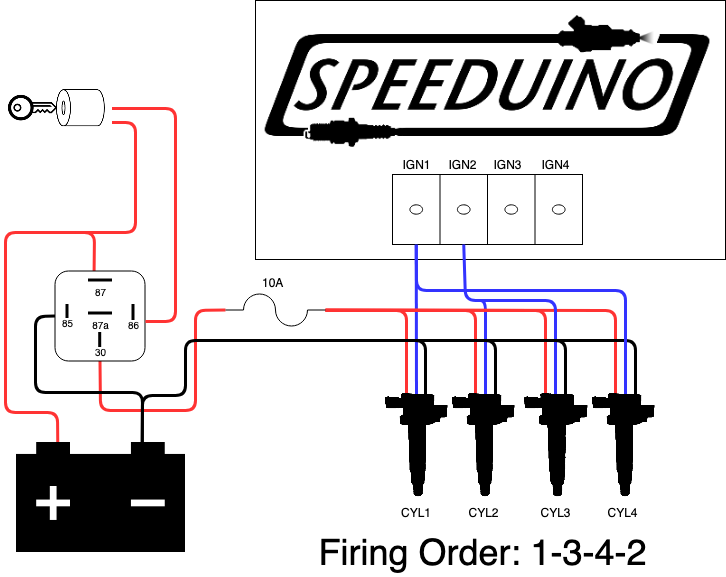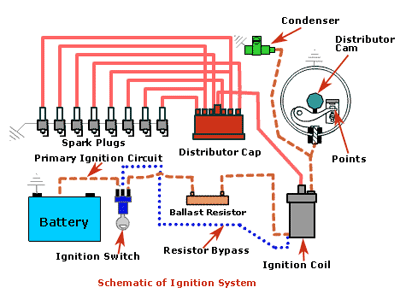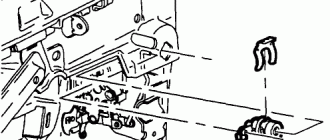
What is the difference between an ignition switch and an ignition cylinder
When it comes to starting a car, there is a crucial component responsible for supplying power to the engine and initiating the ignition process – the ignition switch. While it may be easy to confuse the ignition switch with the ignition cylinder, it is important to understand the key differences between the two.
An ignition switch, also known as an ignition starter switch, is a device that controls the flow of electrical power to various components of a vehicle, such as the starter motor, fuel pump, and ignition system. It is typically located on the steering column or dashboard and is operated by a key. When the key is turned, the ignition switch completes the circuit, allowing electrical current to flow and start the engine.
On the other hand, an ignition cylinder, also referred to as an ignition lock cylinder, is the part of the ignition system that houses the ignition tumbler and key. It is inserted into the ignition switch and is responsible for mechanically engaging and disengaging the ignition switch. The ignition cylinder is crucial for securely starting the vehicle, as it ensures that only the correct key can be used to start the engine.
In summary, the main difference between an ignition switch and an ignition cylinder is that the ignition switch controls the flow of electrical power to various components of the vehicle, while the ignition cylinder is responsible for mechanically engaging and disengaging the ignition switch. Understanding this distinction is important for maintaining and troubleshooting the ignition system of a car.
The Ignition Switch
An ignition switch is a vital component of a vehicle’s electrical system. It is responsible for controlling the power supply to various electrical components, such as the engine, headlights, and accessories. The ignition switch is typically located on the steering column, and it is activated when the key is turned.
The ignition switch is different from the ignition cylinder. While the ignition switch is an electrical component, the ignition cylinder is a mechanical device that houses the ignition key and allows it to be turned. The ignition switch is connected to the ignition cylinder and relies on it to initiate the electrical connection.
So, what is the difference between the ignition switch and the ignition cylinder? The ignition switch controls the flow of electricity, while the ignition cylinder is used to start the vehicle. The ignition cylinder is what you insert the key into and turn to start the engine, while the ignition switch is what activates the electrical components.
In summary, the ignition switch is an electrical component that controls the power supply to various electrical components, and the ignition cylinder is a mechanical device used to start the vehicle. Understanding the difference between the two is important for maintaining and troubleshooting the vehicle’s electrical system.
What is an Ignition Switch?
An ignition switch is a critical component in a vehicle’s electrical system that is responsible for turning the engine on and off. It is located on the steering column or dashboard, and it functions by providing power to various systems and components when the key is inserted and turned.
The ignition switch is different from the ignition cylinder, although they are often confused. While the ignition switch is the electrical component, the ignition cylinder is the physical lock cylinder that the key is inserted into. The ignition switch and ignition cylinder work together to start the vehicle’s engine.
The ignition switch is connected to the battery, starter, and other electrical systems in the vehicle. When the key is turned to the “on” position, the ignition switch supplies power to the starter motor, fuel pump, and other essential components that are needed to start the engine. Once the engine is running, the ignition switch can be turned to the “off” position to shut off the engine and cut off power to the various systems.
In addition to starting and stopping the engine, the ignition switch also controls various electrical accessories in the vehicle, such as the lights, radio, and power windows. It allows these systems to receive power when the key is turned to the appropriate position, and it prevents them from draining the battery when the key is in the “off” position.
In summary, the ignition switch is an essential component in a vehicle that is responsible for starting and stopping the engine, as well as controlling power to various electrical systems. It is different from the ignition cylinder, which is the physical lock cylinder that the key is inserted into.
How Does an Ignition Switch Work?
An ignition switch is an electrical component that is responsible for powering the main electrical systems within a vehicle, such as the ignition, starter motor, and fuel pump. Essentially, it turns on and off the electrical power to these systems, enabling the engine to start and run.
The ignition switch is usually located on the steering column, dashboard, or center console, and is operated by an ignition key. When the key is inserted and turned, it engages a series of electrical contacts inside the switch, allowing electrical current to flow to the necessary components.
What sets the ignition switch apart from the ignition cylinder is its functionality. While the ignition switch controls the electrical power supply to the main systems, the ignition cylinder is responsible for locking and unlocking the steering wheel and engaging the starter motor. The ignition cylinder is where the key is inserted and turned to start the engine.
So, the main difference between an ignition switch and an ignition cylinder is in their tasks and functionalities, although they are closely related. The ignition switch controls the electrical power, while the ignition cylinder allows the key to start the engine.
Common Ignition Switch Problems
An ignition switch is different from an ignition cylinder, but both can experience various problems.
One common problem with an ignition switch is when it becomes faulty and fails to start the vehicle. This can happen due to wear and tear or electrical issues. When the ignition switch is faulty, turning the key may not engage the starter, and the engine will not start.
Another common problem with an ignition switch is a malfunctioning accessory position. The accessory position allows you to operate certain features, such as the radio or power windows, without starting the engine. If the accessory position is not functioning properly, these features may not work as intended.
Ignition switches can also experience problems with the ignition lock cylinder. The ignition lock cylinder is the part of the ignition switch that the key inserts into. If the ignition lock cylinder becomes worn or damaged, it may become difficult or impossible to turn the key in the ignition switch.
In some cases, the ignition switch may fail completely, and the key will not turn at all. This can happen due to a variety of reasons, including a faulty electrical connection or internal component failure. When this happens, the ignition switch may need to be replaced.
It is important to address ignition switch problems as soon as they arise to avoid being stranded without a running vehicle. If you notice any issues with your ignition switch or ignition cylinder, it is recommended to have a professional mechanic inspect and repair the problem.
The Ignition Cylinder
The ignition cylinder is a vital component of a vehicle’s ignition system. It is the part that the ignition key is inserted into to start the car. The ignition cylinder is typically located on the steering column, but can also be found on the dashboard or center console.
The ignition cylinder is responsible for initiating the starting process when the key is turned. It contains a series of tumblers and pins that interact with the key, allowing the cylinder to turn and activate the ignition switch.
One key difference between the ignition cylinder and the ignition switch is that the cylinder is a mechanical component, while the switch is an electrical component. The ignition cylinder is what physically turns and starts the car, while the ignition switch controls the electrical circuits that power the vehicle.
What sets the ignition cylinder apart from other components is its unique key slot. Each ignition cylinder is specifically designed to fit a certain type of key, making it difficult for someone to start a vehicle without the correct key. This security feature helps prevent theft and unauthorized use of the vehicle.
In summary, the ignition cylinder is the mechanical component of a vehicle’s ignition system that the key is inserted into. It works in conjunction with the ignition switch to start the car and has a unique key slot for added security.
What is an Ignition Cylinder?
The ignition cylinder is an essential component of a vehicle’s ignition system. It is a mechanical device that is responsible for starting the engine and controlling the electrical power to various components of the vehicle.
Unlike an ignition switch, which is a binary component that only has two states (on or off), an ignition cylinder is a rotating mechanism that allows for different positions, such as off, accessory, on, and start. The ignition cylinder is usually located on the steering column, and it works in conjunction with the ignition switch to start the vehicle.
The ignition cylinder consists of several parts, including a coded key, a lock tumbler, and a set of electrical contacts. When the correct key is inserted into the cylinder and turned, the lock tumbler engages and rotates the cylinder to the desired position. This action completes the circuit and allows electrical current to flow, starting the engine.
The ignition cylinder plays a crucial role in vehicle security as well. The coding of the key and the unique configuration of the lock tumbler provide a level of protection against theft. Without the correct key, the ignition cylinder cannot be turned, preventing unauthorized access to the vehicle.
In summary, an ignition cylinder is a rotating mechanism that works in conjunction with the ignition switch to start the vehicle. It has different positions, allowing for various functions, and is a vital component for both starting the engine and maintaining vehicle security.
How Does an Ignition Cylinder Work?
The ignition cylinder is an essential component of a vehicle’s ignition system. It is responsible for initiating the ignition process, which allows the engine to start and run. The ignition cylinder is often confused with the ignition switch, and it’s important to understand the difference between the two.
The ignition cylinder is a mechanical device that contains a series of tumblers or pins. These tumblers interact with the key inserted into the cylinder. When the correct key is inserted and turned, the tumblers align to a specific position, allowing the ignition cylinder to rotate. This rotation activates the ignition switch, which in turn activates the starter motor and the fuel injection system.
What sets the ignition cylinder apart from the ignition switch is that it directly interacts with the key. The ignition switch, on the other hand, connects the ignition cylinder to the electrical system of the vehicle. While the ignition switch is responsible for controlling the power supply to various electrical components, the ignition cylinder is simply the mechanical component that allows the ignition process to begin.
The key plays a crucial role in the operation of the ignition cylinder. The unique shape and configuration of the key correspond to the tumblers or pins within the cylinder. When the correct key is inserted and turned, the tumblers align, allowing the cylinder to rotate. If an incorrect key is used, the tumblers will not align properly, preventing the cylinder from rotating and the engine from starting.
In summary, the ignition cylinder is the mechanical component that interacts with the key and initiates the ignition process. It is distinct from the ignition switch, which controls the electrical components of the vehicle. Understanding the difference between the two is important when troubleshooting ignition system issues.
Signs of a Faulty Ignition Cylinder
The ignition cylinder is a critical part of the ignition system in a vehicle. It is responsible for initiating the starting process by activating the ignition switch. However, if there is a problem with the ignition cylinder, it can lead to various issues that can affect the overall performance of the vehicle. Here are some signs that indicate a faulty ignition cylinder:
| Difficulty turning the key | If the key becomes difficult to turn or gets stuck in the ignition cylinder, it could be a sign of a faulty cylinder. This can happen due to worn out components or a damaged cylinder mechanism. |
| Engine not starting | If the ignition cylinder is not functioning properly, it may prevent the engine from starting. This can occur if the cylinder fails to make proper contact with the ignition switch, disrupting the starting process. |
| Intermittent starting issues | A faulty ignition cylinder can cause intermittent starting problems. The engine may start sometimes but not consistently. This can be frustrating and may indicate a worn or damaged ignition cylinder. |
| Strange noises | If you hear unusual clicking or grinding noises when turning the key in the ignition cylinder, it could be a sign of a mechanical issue within the cylinder. This can be caused by worn out components or a damaged cylinder mechanism. |
| Key getting stuck in the cylinder | A faulty ignition cylinder may cause the key to get stuck in the cylinder. This can happen if the cylinder is worn or if there is debris inside that is preventing the key from being removed properly. |
If you experience any of these signs, it is important to have your ignition cylinder inspected and repaired by a professional mechanic. Ignoring the issue can lead to further damage and potentially leave you stranded without a functional vehicle.
The Difference Between Ignition Switch and Ignition Cylinder
An ignition switch and an ignition cylinder are two separate components of a vehicle’s ignition system, but they serve different purposes.
The ignition switch is the main control device that allows a driver to start or stop the engine. It is typically located on the steering column or dashboard, and it can have multiple positions, such as off, accessory, on, and start. Turning the ignition switch to the start position activates the starter motor and starts the engine.
On the other hand, the ignition cylinder is the physical component that the ignition key is inserted into. It is usually located on the steering column or dashboard, near the ignition switch. The ignition cylinder contains tumblers or pins that correspond to the cuts and grooves on the ignition key. When the correct key is inserted into the ignition cylinder and turned, it aligns the tumblers or pins and allows the ignition switch to be turned.
In summary, the ignition switch is the control device that starts or stops the engine, while the ignition cylinder is the physical component that accepts and verifies the ignition key.
Understanding the difference between the ignition switch and ignition cylinder is important for troubleshooting ignition system issues and understanding how the ignition system functions.
Functionality Comparison
When it comes to the functionality, the main difference between an ignition switch and an ignition cylinder lies in the roles they play in starting a vehicle.
An ignition switch is an electrical component that is responsible for controlling the electrical power to various vehicle systems, including the engine. It functions as an on/off switch for the vehicle’s electrical system, allowing the driver to start the engine by turning the switch to the “start” position. The ignition switch also controls other electrical systems such as the lights, radio, and accessories.
On the other hand, an ignition cylinder is a mechanical component that is part of the vehicle’s locking system. It is typically located on the steering column and is used to lock and unlock the vehicle’s ignition. The ignition cylinder is also where the driver inserts the key to start the vehicle. When the key is inserted and turned in the ignition cylinder, it activates the ignition switch, allowing electrical power to flow to the engine and other systems.
In summary, the ignition switch controls the electrical power to the vehicle, while the ignition cylinder is used to start the engine and lock/unlock the vehicle. Both components work together to ensure the proper functioning of the vehicle’s ignition system.
Key Differences
One key difference between an ignition switch and an ignition cylinder is their function. The ignition switch is an electrical device that is used to start or stop the engine. It is typically located on the steering column or dashboard and can be turned on or off with a key. On the other hand, the ignition cylinder is a mechanical component that is part of the ignition switch. It is where the key is inserted and turned to start the engine.
Another difference is the way they are designed. The ignition switch is made up of electrical contacts and circuits that control the flow of electricity to the various systems and components of the vehicle. It is responsible for activating the starter motor, fuel pump, and ignition system. The ignition cylinder, on the other hand, is a cylindrical device with specific grooves and cuts that match the unique pattern of the key. It is designed to fit securely into the ignition switch and allow the key to be inserted and turned.
One important distinction to note is that the ignition switch is typically a one-piece unit, meaning it cannot be disassembled or repaired. If there is a problem with the ignition switch, it usually needs to be replaced entirely. On the other hand, the ignition cylinder can often be repaired or replaced separately from the ignition switch. This is because the ignition cylinder is a separate component that can be removed and replaced without affecting the overall function of the ignition switch.
In summary, the key difference between an ignition switch and an ignition cylinder is that the switch is the electrical component used to start or stop the engine, while the cylinder is the mechanical component that holds and turns the key. The switch controls the flow of electricity to different vehicle systems, while the cylinder allows the key to be inserted and turned. Additionally, the switch is typically a one-piece unit that needs to be replaced entirely if there is a problem, while the cylinder can often be repaired or replaced separately.
When to Replace the Ignition Switch or Ignition Cylinder
The ignition switch and ignition cylinder are two important components of a vehicle’s ignition system. While they both play a role in starting the engine, there is a difference between the two.
The ignition switch is an electrical component that is typically located on the steering column of a vehicle. It is responsible for controlling the power to various electrical systems, including the starter motor. When the ignition switch is turned to the “on” position, it allows electricity to flow and activates the starter motor to start the engine.
On the other hand, the ignition cylinder is a mechanical component that is connected to the ignition switch. It is usually located on the steering wheel shaft and contains a series of pins and tumblers. When a key is inserted into the ignition cylinder and turned, it aligns the pins and tumblers to allow the ignition switch to be turned.
Knowing when to replace the ignition switch or ignition cylinder is important for maintaining the functionality of your vehicle’s ignition system. Here are some signs that may indicate it’s time for a replacement:
| – Difficulty turning the key | – Key won’t turn or gets stuck |
| – Issues with starting the engine | – Engine won’t start or stalls |
| – Power loss to electrical systems | – Key can be removed while engine is running |
| – Electrical problems (e.g. radio not working) | – Key feels loose or wobbly in the cylinder |
If you are experiencing any of these issues, it is recommended to have a professional mechanic inspect your ignition switch or ignition cylinder. They can diagnose the problem and determine whether a replacement is necessary.
By understanding the difference between the ignition switch and ignition cylinder and knowing when to replace them, you can ensure the proper functioning of your vehicle’s ignition system and avoid potential starting or electrical problems.
Signs it’s Time to Replace the Ignition Switch
Understanding the difference between an ignition switch and an ignition cylinder is important in identifying signs that it’s time to replace the ignition switch. While the ignition cylinder is responsible for housing and turning the car key, the ignition switch itself is an electrical component that controls the engine’s ignition system.
- One of the common signs that it’s time to replace the ignition switch is when the car fails to start or experiences intermittent starting issues. This could be due to a faulty ignition switch that is unable to properly send the signal to the starter solenoid.
- Another indication that the ignition switch needs to be replaced is when there is difficulty in turning the key in the ignition cylinder. If the key becomes stiff or starts to stick, it could be a sign of a worn-out ignition switch.
- Frequent stalling of the engine can also be a sign that the ignition switch is failing. When the ignition switch is faulty, it can cause the engine to lose power and stall unexpectedly.
- In some cases, the dashboard lights may flicker or behave erratically when the ignition switch is worn out. This can be a result of a loose connection within the switch.
- An overheated ignition switch is another warning sign that it needs to be replaced. If the switch becomes hot to the touch after prolonged use, it indicates a potential electrical problem that should be addressed.
It’s important to address these signs promptly and replace the ignition switch if necessary. Ignoring these signs can lead to further damage or even safety hazards while driving.
Signs it’s Time to Replace the Ignition Cylinder
Knowing when it’s time to replace the ignition cylinder can help prevent inconvenient breakdowns and ensure the safety of your vehicle. Here are some signs that indicate it’s time for a replacement:
- Difficulties in turning the key: If you find it increasingly hard to turn the key in the ignition cylinder, it could be a sign that the cylinder is worn out and needs replacing. Ignoring this issue could lead to complete failure, leaving you stranded.
- Key getting stuck: Another sign of a failing ignition cylinder is when the key gets stuck in the cylinder and becomes difficult to remove. This can be caused by damaged or worn out internal components, requiring a replacement cylinder.
- Intermittent starting problems: If you experience intermittent starting problems, such as the engine not turning over or the vehicle not starting at all, it could be a result of a faulty ignition cylinder. Inconsistent contact between the key and cylinder can cause these issues, indicating the need for a replacement.
- Ignition switch issues: While the ignition switch and ignition cylinder are separate components, they work together to start the vehicle. If you are having problems with the ignition switch, such as the engine not starting even with a functioning ignition cylinder, it is possible that the switch and cylinder need to be replaced together.
Remember, the ignition cylinder is a vital component in your vehicle’s ignition system. If you notice any of these signs, it’s important to have it replaced by a professional to avoid further complications.
Q&A:
What is the difference between an ignition switch and an ignition cylinder?
An ignition switch is the electrical component that controls the flow of electricity to the starter motor, while the ignition cylinder is the mechanical device into which the ignition key is inserted.
How do I know if my ignition switch is faulty?
If you’re having trouble starting your car, or if you notice electrical issues such as a malfunctioning radio or power windows, it could indicate a faulty ignition switch. A professional mechanic can diagnose and replace the switch if needed.
Can I replace the ignition switch myself?
Replacing an ignition switch can be a complex task that requires specialized knowledge and tools. Unless you have experience working on car electrical systems, it’s generally recommended to have a professional handle the replacement.
Can I replace just the ignition cylinder without replacing the ignition switch?
In some cases, you may be able to replace just the ignition cylinder without having to replace the entire ignition switch. However, this will depend on the specific make and model of your vehicle, so it’s best to consult a professional for guidance.
How long does it take to replace an ignition switch?
The time it takes to replace an ignition switch can vary depending on the complexity of the job and the specific vehicle. On average, it may take a professional mechanic anywhere from 1 to 3 hours to complete the replacement.
What is the difference between an ignition switch and an ignition cylinder?
An ignition switch is an electrical component that is responsible for activating the vehicle’s electrical system, while an ignition cylinder is a mechanical component that is used to start the engine by turning the key.
How does an ignition switch work?
An ignition switch works by receiving a signal from the key when it is inserted and turned. This signal then allows the electrical current to flow to different systems in the vehicle, such as the starter, fuel pump, and ignition system.







